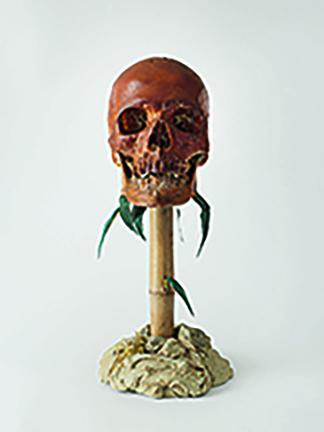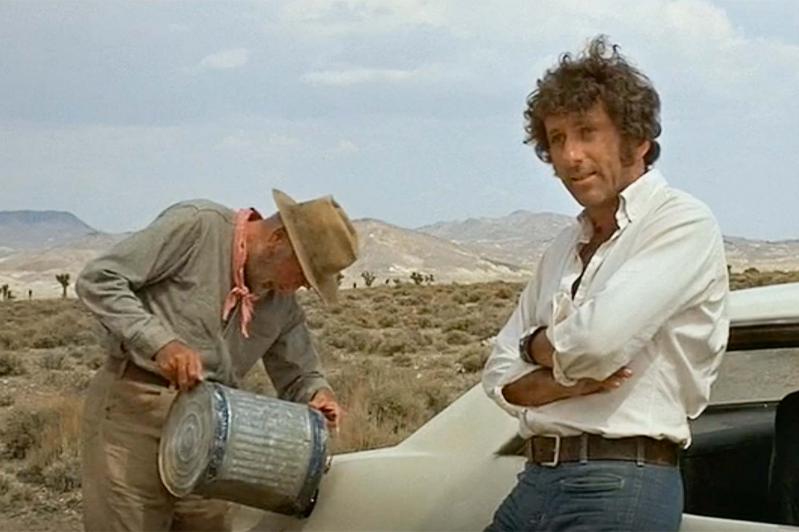Robert M. Rubin is, among many things, a writer, curator, and collector. On Saturday, the Sag Harbor Cinema will focus on his collecting, with “Movie Art and Artifacts From a Private Collection,” and his writing, with a book signing of his “Vanishing Point Forever,” a multifaceted exploration of the 1971 cult film “Vanishing Point,” which will be shown at 6 p.m., before the signing.
The exhibition, on view on the cinema’s third floor, includes contemporary art incorporating imagery from movies, artifacts of the moviemaking process such as set designs and props, screenplay drafts, and set and continuity photographs.
“I have been an admirer of Bob Rubin’s collecting philosophy and his passion for cinema,” Giulia D’Agnolo Vallan, the cinema’s artistic director, said. “It is a vision where film intersects the other arts and permeates the way we interpret the world that I strongly identify with and draws from some of my favorite endeavors of Hollywood history, both sophisticated and irreverent.”
During a Zoom conversation, Mr. Rubin, a Wainscott resident and founder of the Bridge Golf Club in Bridgehampton, said that it was at a book fair that he saw a copy of a screenplay of “Blade Runner,” which at the time bore the title of the book on which it was based, Philip K. Dick’s “Do Androids Dream of Electric Sheep?”
“That was my entry down the rabbit hole of screenplays and production materials.” But he was not interested in the final, published screenplays one might find in the collection of the Motion Picture Academy, but rather earlier drafts whose archival value lies in the distance between them and what winds up on the screen. “The space between the draft and the final product is what interests me,” he said.
As for “Vanishing Point,” directed in 1971 by Richard C. Sarafian from a script by Guillermo Cabrera Infante, a Cuban novelist, the film stars Barry Newman as Kowalski, a car delivery driver racing against time to get a white 1970 Dodge Challenger from Denver to San Francisco at the end of the 1960s.
It also features Cleavon Little as a blind disc jockey who encourages Kowalski to evade the police, Dean Jagger as an old prospector, and Charlotte Rampling in a brief appearance as a hitchhiker. And, of course, the aptly named Challenger itself, which encounters, and overcomes, an endless series of challenges.
“What’s weird about ‘Vanishing Point’ is how hard it is to see,” Mr. Rubin said. “You can’t stream it,” which is why the screening at the cinema is a rare opportunity.
“ ‘Vanishing Point’ is very hard to pin down as a movie. Is it a magical realist road movie? Is it a car chase movie? Is it a kiss the ‘60s goodbye movie? Is it an augur of the surveillance society? It’s kind of a mishmash of all of those. It doesn’t really know what it wants to be, and that’s part of its charm.”
Before casting Newman, who died last year, the producers considered George C. Scott and Gene Hackman. “It would have been a very, very different movie if either of them had taken the role, because they bring a persona. Newman is a total cipher, and that allows you to project onto him what you want the movie to be, and what you want him to be. Is he the last American hero, is he a cowboy, is he a victim?”
The importance of the film for Mr. Rubin is what he calls its “long tail,” its afterlife in films such as those of Quentin Tarantino, as well as in music, books, and visual art.
“Vanishing Point Forever,” just published by RideWithBob/Film Desk Books, includes draft scripts for the film,
stills, the final shooting script, and texts by J. Hoberman, Rita Guibert, Richard Prince, Alberto Moravia, Rick Lyman, Infante, who wrote the screenplay under the pseudonym of Guillermo Cain, and Mr. Rubin.
Of his film collection, Mr. Rubin said, “There’s the idea of creating meaning by aggregating stuff. What I’m creating is a series of archives around a series of movies, a series that includes westerns, New Hollywood, and film noir. I’ve got thousands of these screenplays now. It’s an archive that’s going to keep people busy for generations.”

Among the items on view at the cinema are props from “Apocalypse Now”; two works by Mr. Prince, including one based on Dennis Hopper in “The Last Movie”; an exhibition poster with an image from “Bullitt”; a tribute in oil to “The French Connection” by Ivan Messac, a French artist; an imagined “Heart of Darkness” poster by Fiona Banner for Orson Welles’s unrealized adaptation of the Joseph Conrad novel, and a piece from the artist Pierre Bismuth’s “Following the right hand of . . .” series, featuring Barbara Stanwyck in “Double Indemnity.”
The exhibition will remain on view until early August.




